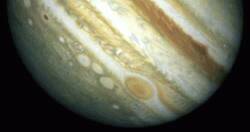 Jupiter
Jupiter
Temperature raises of course until in the nucleus there are about 12.000.000 °C . If the nebula have less matter, then star doesn't blow up at 100% but it became a "Brown dwarf", or a small low temperature and low brightness star.
Less less matter makes
instead Jupiter or Saturn like object that could be "undone
stars".
 Jupiter
Jupiter
However if the quantity of matter is few then will born a red star that have a long life for the reasons the we will analyze after.
Else, if matter is plentiful then will born giant blue star that have a short life. This are two extreme cases: a small red star and a giant blue star. There are, in fact, stars like Sun and stars like Sun are yellow.
Stars color is related with temperature of the star and then it indicates the stars mass.
Hertsprung-Russell diagram shows this relations between mass, color and brightness. Main sequence is the medium stars like Sun are in. Spectral class is a classification of the stars by the temperature and color. It is between blue and red. Sequence of the classification is O-B-A-F-G-K-M-N-R.
Nuclear fusion process
produce energy and temperature raises rapidly.
Around the star there are dusts and the system rotates. During
rotation heavier elements crash their self and they start to
makes planets and moons. This is a solar system birth. This solar
system formation might be usually in the universe in the case of
single stars. A difference exists when there are binary stars.
When temperature in the
nucleus raise 12.000.000 °C star blows up and starts evolution
time. In the fusion process it creates elium. By one kilo of
hydrogen stars can produce 200 tons petroleum energy, and it's
this energy gives us life.
If hydrogen produce an efficient energy, elium doesn't make the
same. Its energy is less efficient and it's worrisome for the
star's life.
Nuclear fusion process is less efficient from the hydrogen to the
iron. Infact the iron doesn't produce energy but it absorbs
energy. This process makes disaster in the star life.